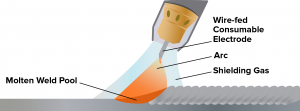
Introduction
Welding is the process of joining two pieces of metal together by passing electricity through the pieces to melt them. Welding is common because it forms a continuous seal with no leaks. When done correctly, the seal can be just as strong as the material itself.
Welding is also popular because it doesn’t require a filler metal or any other external components, so the connection has a smaller mass. Welding is often used for repair work, because there is minimal stress at the attachment points, so the connection isn’t very likely to break.
Welding is a very dangerous technique that requires extensive training. It is an excellent way to attach metal, but if safety precautions are ignored, the welder can incur serious injury or even death.
How it Works
There are three main types of welding: Tungsten Inert Gas (TIG), Metal Inert Gas (MIG), and Stick Welding. Although each of these processes have their own pros and cons, the basic concept is the same. The general process of welding metal together involves shooting the connection point with a large electrical current which melts the metal. When the metal cools, the two pieces are permanently stuck together.
Tungsten Inert Gas Method (TIG)

This method is the most common for small welding processes. A torch holds a tungsten electrode and the welder uses a foot pedal to control the current flowing into the electrode. The electrode itself does not melt, but heats up enough to melt the metal that the welder is working with. Then, an inert gas (usually Argon) is passed over the metal to cool and harden the weld.
Metal Inert Gas (MIG)

Metal Inert Gas welding is similar to TIG welding, except that the electrode is consumable, so it melts and acts as a filler metal in the weld. The wire is fed into the weld with a motorized spool. An inert gas (usually Argon) is used to shield the weld environment and cool the weld. MIG welding is usually faster than TIG and easier to control, but it usually makes a weaker weld.
Stick Welding

In stick welding, instead of a torch, there is a stick electrode which is held in place by a special clamp. The stick electrode is composed of filler metal and surrounded by flux. When the electrical current passes through the electrode, the filler metal melts onto the desired connection. At the same time, the flux volatilizes into a gas that acts as a protection to the welding environment. Stick welding can withstand very high winds and adverse weather conditions, so it is often used in construction welding.
Welding Safety Hazards
As mentioned above, there are some serious safety hazards associated with welding. Listed below are the top four concerns and some steps that can be taken to reduce the risk welding.
Electric Shock: Since it requires a large amount of electrical current to pass through the electrode in order to heat the metal, there is a very high risk of electric shock to the welder. This can occur when the welder touches two objects together that have voltages running through them (basically puts the person into the circuit). Arc welding circuits usually range anywhere from 20-100 V, and just 50 V is enough shock to kill a person. In order to reduce the risk for electric shock, make sure to wear dry gloves, and never touch the electrode with exposed or wet fingers. Additionally, be sure to inspect the electrode for any damage before use. If an electrode is damaged, there is a much higher risk for electric shock to the user.
Fumes and Gases: When the metals melt together, they can form hazardous complex metal oxide compounds. These compounds can form harmful gases and fumes in the welding area. To avoid these fumes, be sure to work in a properly ventilated area that removes gases from the room.
Fires and Explosions: The arc welding circuits can reach temperatures of up to 10,000 degrees Fahrenheit. During the welding process, there are lots of high temperature sparks that fly all over. They can easily land on flammable materials and cause fires or big explosions. To prevent this from happening, make sure to remove all flammable materials from the welding environment.
Proper Personal Protective Equipment (PPE): While welding, it is extremely important to wear the proper clothing and protective equipment. This includes a full face mask to shield the welder from spatter, thick gloves, leather or flame-resistant treated cotton clothing, and sometimes noise-cancelling headphones.

Welding Locations on Campus
- Mechanical Engineering Shop (Hammerschlag C Level)
- Requires quote
- Expensive
- Chemical Engineering Shop (Doherty A Level)
- Requires quote
- Expensive
- Carnegie Mellon Racing Garage ((East Campus Garage Basement)
- Join team and be trained
- “Bribe team welder with food and drink”
- School of Art MetalFab Shop (Doherty 200A)
- Take class
- Find friend who has taken the class
- Field Robotics Center (FRC) Robotics Shop (Gates)
- Join FRC
http://ideate.xsead.cmu.edu/gallery/projects/welding
https://www.lincolnelectric.com/en-us/support/welding-solutions/Pages/Five-potential-welding-safety-hazards.aspx